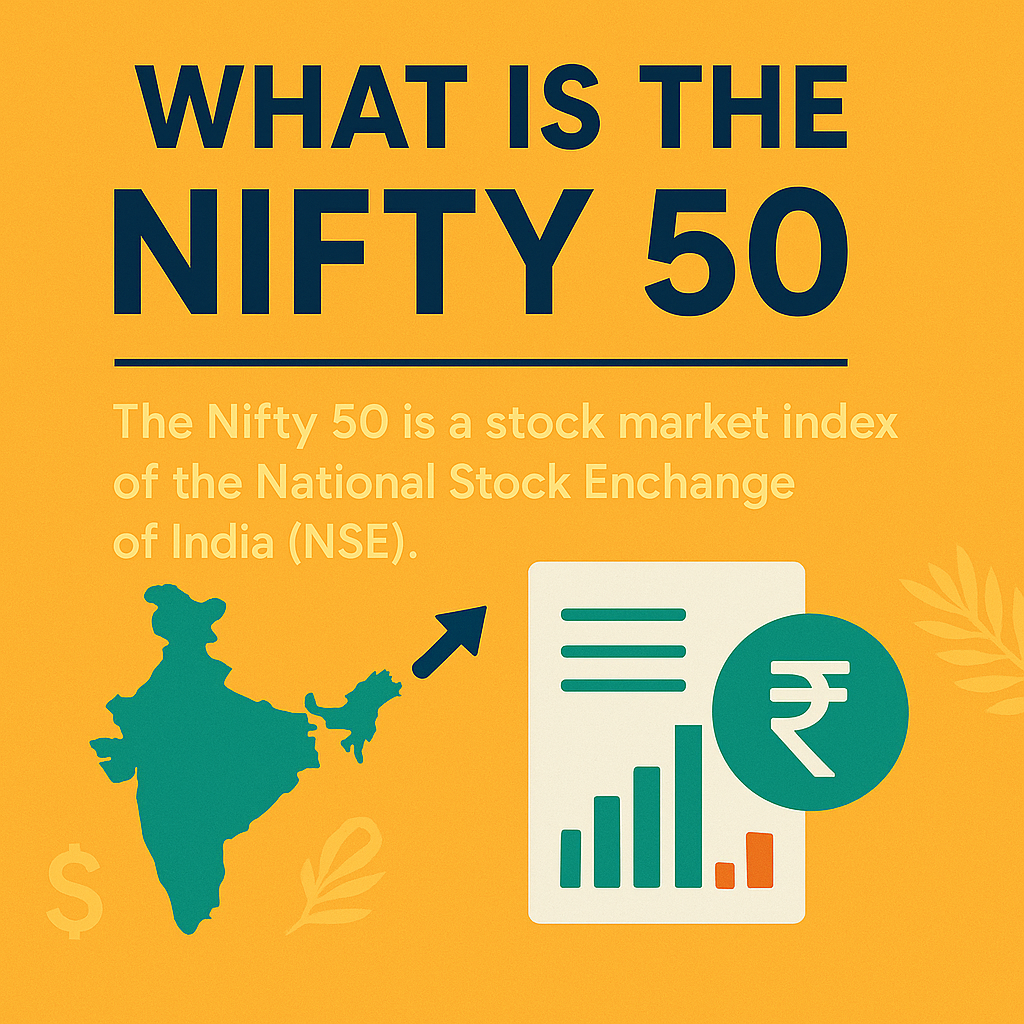The Nifty 50 is a vital barometer of the Indian stock market, representing the top 50 companies across various sectors of the economy. Managed by the National Stock Exchange (NSE), the Nifty 50 is a benchmark index that provides a snapshot of the overall health of India’s stock market. Whether you’re an investor or someone interested in the financial markets, understanding the Nifty 50 is crucial to navigating the complexities of India’s stock market.
In this blog, we will delve into the history, composition, performance, and impact of the Nifty 50 index, and why it plays such an essential role for investors. We’ll also highlight the top companies listed in the Nifty 50 and provide insights on how it influences investment decisions in India.

1. What is the Nifty 50?
The Nifty 50 is an index that consists of 50 of the largest publicly traded companies in India, selected based on market capitalization, liquidity, and other factors. These companies span across 13 sectors, such as automobiles, technology, finance, pharmaceuticals, and more. The Nifty 50 is considered an excellent representation of the Indian stock market’s overall performance.

Nifty 50 vs. Sensex:
- While the Sensex tracks the performance of the 30 largest companies listed on the Bombay Stock Exchange (BSE), the Nifty 50 represents the top companies on the National Stock Exchange (NSE).
- Both indices are widely used by investors, analysts, and policymakers to gauge market sentiment and economic performance.
2. How is the Nifty 50 Calculated?
The Nifty 50 is a free-float market capitalization-weighted index, meaning that the weight of each stock in the index is based on its market capitalization and the proportion of shares available for trading (free float). Companies with a higher market cap have a larger weight in the index, affecting its overall performance more than smaller companies.

Formula for Calculating Nifty 50:
The formula for calculating Nifty 50 is:
pgsqlCopyNifty 50 Index = (Current Market Value of Index / Base Market Value) * Base Value
Where the Base Market Value is the total market value of the Nifty 50 index at the time it was launched in 1995, and the Base Value is set at 1000.
3. Components of the Nifty 50:
The Nifty 50 is made up of companies from various sectors, offering a diversified outlook on the Indian economy. Here are some key sectors and top companies in the index:
Top Sectors in Nifty 50:
- Financials: This is the largest sector in the Nifty 50, comprising companies like HDFC Bank, ICICI Bank, and Kotak Mahindra Bank.
- Information Technology (IT): Companies like Tata Consultancy Services (TCS), Infosys, and HCL Technologies represent this sector.
- Energy: Major players like Reliance Industries, NTPC, and Indian Oil Corporation (IOC) are part of this group.
- Consumer Goods: Companies such as Hindustan Unilever, ITC, and Nestlé India dominate this space.
- Automobile: With companies like Maruti Suzuki and Mahindra & Mahindra, this sector is also well represented.
Top Companies in Nifty 50:
- Reliance Industries: The largest company by market capitalization in India.
- HDFC Bank: One of India’s top private-sector banks.
- Tata Consultancy Services (TCS): A leader in IT services and consulting.
- Infosys: Another global IT giant.
- ICICI Bank: One of the largest banks in India.
4. Performance and Historical Growth of Nifty 50
Since its inception in 1995, the Nifty 50 has witnessed substantial growth, with some significant periods of volatility. Over the decades, it has reflected the changing dynamics of the Indian economy, including major reforms, the rise of the technology sector, and global financial crises.
Nifty 50 Milestones:
- 1995: The Nifty 50 was launched with a base value of 1000.
- 2000s: The index saw rapid growth due to India’s emerging market status and the tech boom.
- 2008: The global financial crisis caused a sharp decline in Nifty, but the market recovered in the following years.
- Post-2010: India’s economic reforms and a growing middle class have contributed to the steady rise in the Nifty 50, especially in sectors like technology and banking.
5. Why is the Nifty 50 Important for Investors?
The Nifty 50 index is one of the primary benchmarks for investors in India. It serves as a reference point for evaluating the performance of mutual funds, exchange-traded funds (ETFs), and other investment portfolios. Here are a few reasons why Nifty 50 is so important:
Diversification:
Since the Nifty 50 is made up of 50 large-cap companies from different sectors, it provides a well-diversified view of the Indian economy, reducing risk for investors.
Investment in Nifty 50:
Investors looking for consistent returns and exposure to the Indian market often invest in Nifty 50-related index funds or ETFs. These funds track the performance of the Nifty 50 index, giving investors broad market exposure.
Market Sentiment:
The Nifty 50 index is an excellent barometer of overall market sentiment. A rising Nifty 50 usually indicates investor confidence in the economy, while a declining index often points to economic concerns or market corrections.
6. Nifty 50 and Its Role in Economic Indicators
The performance of the Nifty 50 is closely tied to the economic growth and market trends in India. The index serves as a leading indicator of the health of the Indian economy, providing insights into:
- Investor Confidence: A rising Nifty signals positive market sentiment, while a fall could indicate uncertainty.
- Economic Growth: Strong growth in the Nifty 50 suggests robust economic performance across sectors like banking, technology, and energy.
- Inflation and Interest Rates: The Nifty reacts to changes in inflation and interest rates, which impact investor behavior.
7. Impact of Global Events on Nifty 50
The Nifty 50 is also influenced by global events such as the Israel-Iran conflict or global pandemics, which can lead to market volatility. Factors such as foreign investments, global commodity prices, and geopolitical tensions can impact the index, reflecting both external risks and growth opportunities in India’s stock market.
8. Future of Nifty 50: What to Expect
As India’s economy continues to evolve, the Nifty 50 index will likely undergo further changes. With increasing digitalization, financial sector growth, and the rise of sustainable energy, the future of Nifty 50 looks promising. The inclusion of more new-age tech companies and the potential for new sectors to join the index could make it even more dynamic and reflective of global market trends.
🔗 External Links for Further Reading
🌤️ Mausam: Understanding Weather Forecasting and Its Impact on Life